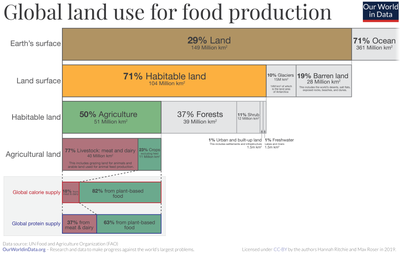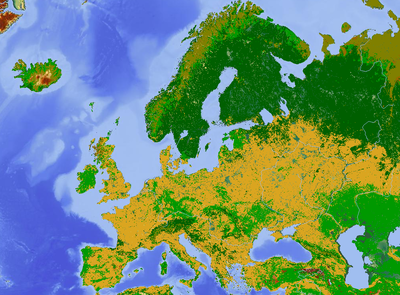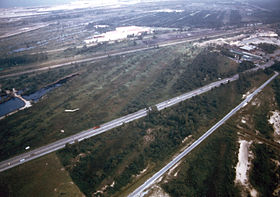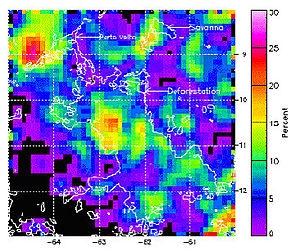Land use

Land useinvolves the management and modification ofnatural environmentorwildernessintobuilt environmentsuch assettlementsand semi-natural habitats such asarable fields,pastures,and managedwoods.Land use by humans has a long history, first emerging more than 10,000 years ago.[1][2]It has been defined as "the purposes and activities through which people interact with land and terrestrial ecosystems"[3]and as "the total of arrangements, activities, and inputs that people undertake in a certainlandtype. "[4]Land use is one of the most important drivers ofglobal environmental change.[3][5]
History
[edit]
Human tribes sinceprehistoryhave segregated land intoterritoriesto control the use of land. Today, the totalarable landis 10.7% of the land surface, with 1.3% being permanent cropland.[6][7]
Regulation
[edit]
Land use practices vary considerably across the world. TheUnited Nations'Food and Agriculture OrganizationWater Development Division explains that "Land use concerns the products and/or benefits obtained from use of the land as well as the land management actions (activities) carried out by humans to produce those products and benefits."[8]As of the early 1990s, about 13% of theEarthwas considered arable land, with 26% in pasture, 32% forests and woodland, and 1.5% urban areas.Land change modelingcan be used to predict and assess future shifts in land use.
As Albert Guttenberg (1959) wrote many years ago,"'Land use' is a key term in the language ofcity planning."[9]Commonly, politicaljurisdictionswill undertakeland-use planningand regulate the use of land in an attempt to avoidland-use conflicts.Land use plans are implemented through land division and use ordinances and regulations, such aszoning regulations.Management consultingfirms andnon-governmental organizationswill frequently seek to influence these regulations before they are codified.
United States
[edit]
In colonial America, few regulations were originally put into place regarding the usage of land. As society shifted from rural to urban, public land regulation became important, especially to city governments trying to control industry, commerce, and housing within their boundaries. The first zoning ordinance was passed inNew York Cityin 1916,[10][11]and, by the 1930s, most states had adoptedzoninglaws. In the 1970s, concerns about the environment and historic preservation led to further regulation.
Today, federal, state, and local governments regulate growth anddevelopmentthroughstatutory law.The majority of controls on land, however, stem from the actions of private developers and individuals. Three typical situations bringing such private entities into the court system are: suits brought by one neighbor against another; suits brought by a public official against a neighboring landowner on behalf of the public; and suits involving individuals who share ownership of a particular parcel of land. In these situations, judicial decisions and enforcement of private land-use arrangements can reinforce public regulation, and achieve forms and levels of control that regulatory zoning cannot. There is growing concern that land use regulation is a direct cause of housing segregation in the United States today.[12]
Two major federal laws passed in the 1960s limit the use of land significantly. These are theNational Historic Preservation Act of 1966(today embodied in 16 U.S.C. 461 et seq.) and theNational Environmental Policy Actof 1969 (42 U.S.C. 4321 et seq.).
TheUS Department of Agriculturehas identified six major types of land use in the US. Acreage statistics for each type of land use in thecontiguous 48 statesin 2017 were as follows:[13]
| Use | acreage (M) | km2(M) | % of total |
|---|---|---|---|
| Pasture/range | 654 | 2.647 | 35 |
| Forest | 538.6 | 2.18 | 28 |
| Cropland | 391.5 | 1.584 | 21 |
| Special use* | 168.8 | 0.683 | 9 |
| Miscellaneous* | 68.9 | 0.279 | 4 |
| Urban | 69.4 | 0.281 | 4 |
| Total** | 1,891 | 7.653 | 100 |
- Special useareas include national parks (29 M acres) and state parks (15 M), wildlife areas (64.4 M), highways (21 M), railroads (3M), military bases (25 M), airports (3M) and a few others.Miscellaneousincludes cemeteries, golf courses, marshes, deserts, and other areas of "low economic value". ** The total land area of the US is 9.1 M km2but the total used here refers only to the contiguous 48 states, without Alaska etc.
Urban growth boundary
[edit]Theurban growth boundaryis one form of land-use regulation. For example,Portland, Oregonis required to have an urban growth boundary which contains at least 20,000 acres (81 km2) of vacant land. Additionally, Oregon restricts the development of farmland. The regulations are controversial, but an economic analysis concluded that farmland appreciated similarly to the other land.[14]
Environment
[edit]| Categories | Contribution of farmed animal product [%] |
|---|---|
| Calories | 18
|
| Proteins | 37
|
| Land use | 83
|
| Greenhouse gases | 58
|
| Water pollution | 57
|
| Air pollution | 56
|
| Freshwater withdrawals | 33
|
| Food Types | Land Use (m2year per 100g protein) |
|---|---|
| Lamb and Mutton | 185
|
| Beef | 164
|
| Cheese | 41
|
| Pork | 11
|
| Poultry | 7.1
|
| Eggs | 5.7
|
| Farmed Fish | 3.7
|
| Groundnuts | 3.5
|
| Peas | 3.4
|
| Tofu | 2.2
|
Land use andland managementpractices have a major impact onnatural resourcesincludingwater,soil,nutrients,plantsandanimals.[17][18]Land use information can be used to develop solutions for natural resource management issues such as salinity andwater quality.For instance, water bodies in a region that has beendeforestedor having erosion will have different water quality than those in areas that areforested.Forest gardening,a plant-based food production system, is believed to be the oldest form of land use in the world.[19]
The major effect of land use onland coversince 1750 has beendeforestationoftemperate regions.[20]More recent significant effects of land use includeurban sprawl,soil erosion,soil degradation,salinization,anddesertification.[21]Land-use change,together with use offossil fuels,are the majoranthropogenicsources of carbon dioxide, a dominantgreenhouse gas.[22]
According to a report by theUnited Nations'Food and Agriculture Organization,land degradationhas been exacerbated where there has been an absence of any land use planning, or of its orderly execution, or the existence of financial or legal incentives that have led to the wrong land use decisions, or one-sided central planning leading toover-utilizationof the land resources - for instance for immediate production at all costs. As a consequence the result has often been misery for large segments of the local population and destruction of valuablehabitatsandecosystems.
Land use change
[edit]
See also
[edit]- Agricultural district
- Building setback– Step-like recession in a wall
- Cultural landscape– Landscape, which is permanently em Boss ed by humans
- Land Allocation Decision Support System
- Land Use Evolution and Impact Assessment Model
- Land-use forecasting– Projecting the distribution and intensity of trip generating activities in the urban area
- Indirect land use change impacts of biofuels– Negative spillover effect of production of biofuels
- Land change modeling– Geographic and ecological field of study
- Land-use planning– Process of regulating the use of land by a central authority
- Land-use conflict– disagreement about what a particular area of land should be used for
- Variance (land use)– administrative exception to land use regulations
References
[edit]- ^Ellis, Erle; Goldewijk, Kees Klein; Gaillard, Marie-José; Kaplan, Jed O.; Thornton, Alexa; Powell, Jeremy; Garcia, Santiago Munevar; Beaudoin, Ella; Zerboni, Andrea (2019-08-30). "Archaeological assessment reveals Earth's early transformation through land use".Science.365(6456): 897–902.Bibcode:2019Sci...365..897S.doi:10.1126/science.aax1192.hdl:10150/634688.ISSN0036-8075.PMID31467217.S2CID201674203.
- ^Ellis, Erle C.; Gauthier, Nicolas; Goldewijk, Kees Klein; Bird, Rebecca Bliege; Boivin, Nicole; Díaz, Sandra; Fuller, Dorian Q.; Gill, Jacquelyn L.; Kaplan, Jed O.; Kingston, Naomi; Locke, Harvey (2021-04-27)."People have shaped most of terrestrial nature for at least 12,000 years".Proceedings of the National Academy of Sciences.118(17): e2023483118.Bibcode:2021PNAS..11823483E.doi:10.1073/pnas.2023483118.ISSN0027-8424.PMC8092386.PMID33875599.
- ^abMeyfroidt, P.; Roy Chowdhury, R.; de Bremond, A.; Ellis, E. C.; Erb, K. -H.; Filatova, T.; Garrett, R. D.; Grove, J. M.; Heinimann, A.; Kuemmerle, T.; Kull, C. A. (2018-11-01)."Middle-range theories of land system change"(PDF).Global Environmental Change.53:52–67.doi:10.1016/j.gloenvcha.2018.08.006.ISSN0959-3780.S2CID158366220.
- ^"Land Use, Land-Use Change and Forestry".grida.no.Archivedfrom the original on December 6, 2017.RetrievedSeptember 29,2022.
- ^Ellis, Erle C. (2021-10-18)."Land Use and Ecological Change: A 12,000-Year History".Annual Review of Environment and Resources.46(1): 1–33.doi:10.1146/annurev-environ-012220-010822.ISSN1543-5938.S2CID244592514.
- ^"World Bank arable land".World Bank.Archivedfrom the original on October 2, 2015.RetrievedOctober 19,2015.
- ^"World Bank permanent cropland".World Bank.Archivedfrom the original on July 13, 2015.RetrievedOctober 19,2015.
- ^FAO Land and Water Divisionretrieved 14 September 2010
- ^JAPA 25:3
- ^Village of Euclid, Ohio v. Ambler Realty Co.
- ^Nolon, John R. (July–August 1992)."Local Land Use Control in New York: An Aging Citadel Under Siege".New York State Bar Journal:38.
- ^Trounstine, Jessica (May 2020)."The Geography of Inequality: How Land Use Regulation Produces Segregation".American Political Science Review.114(2): 443.doi:10.1017/S0003055419000844.S2CID213239635.
- ^abMerrill, Dave; Leatherby, Lauren (July 31, 2018)."Here's How America Uses Its Land".Bloomberg.Retrieved2018-08-05.
- ^Jaeker WG, Plantinga AJ (2007).How have Land-use regulations Affected Property Values in Oregon?Archived2012-07-22 at theWayback MachineOSU Extension.
- ^Carrington, Damian (31 May 2018)."Avoiding meat and dairy is 'single biggest way' to reduce your impact on Earth".The Guardian.Retrieved19 August2018.
- ^Nemecek, T.; Poore, J. (2018-06-01)."Reducing food's environmental impacts through producers and consumers".Science.360(6392): 987–992.Bibcode:2018Sci...360..987P.doi:10.1126/science.aaq0216.ISSN0036-8075.PMID29853680.
- ^Ameztegui, Aitor; Coll, Lluis; Brotons, Lluis; Ninot, J.M. (2016)."Land-use legacies rather than climate change are driving the recent upward shift of the mountain tree line in the Pyrenees"(PDF).Global Ecology and Biogeography.25(3): 263–273.doi:10.1111/geb.12407.hdl:10459.1/65151.Archived(PDF)from the original on August 9, 2021.RetrievedSeptember 8,2022.
- ^"Chapter 1 - Meaning of Land"(PDF).Global Land Outlook (Report).United Nations Convention to Combat Desertification.2017. p. 21.ISBN978-92-95110-48-9.Archived(PDF)from the original on September 20, 2022.RetrievedSeptember 18,2022.
- ^Hart, Robert (1996).Forest Gardening.p. 124.ISBN9781603580502– viaGoogle Books.
Forest gardening, in the sense of finding uses for and attempting to control the growth of wild plants, is undoubtedly the oldest form of land use in the world.
- ^"Changes in Atmospheric Constituents and in Radiative Forcing"(PDF).Intergovernmental Panel on Climate Change.Archived fromthe original(PDF)on December 15, 2007.
- ^UN Land Degradation and Land Use/Cover Data Sourcesret. 26 June 2007
- ^"UN Report on Climate Change"(PDF).Archived fromthe original(PDF)on February 3, 2007.RetrievedJune 25,2007.
- ^"Land Change Science Program - Science".usgs.gov.Archivedfrom the original on 2021-02-10.Retrieved2021-02-09.
External links
[edit]- Land-use and land-cover change defined at Encyclopedia of Earth
- Land Use Law News Alert
- Land Use Lawby Prof.Daniel R. Mandelker(Washington University in St. Louis School of Law)
- The Relationship Between Land Use Decisions and the Impacts on Our Water and Natural Resources
- Land Use Accountability ProjectThe Center for Public Integrity
- Schindler's Land Use Page(Michigan State UniversityExtension Land Use Team)
- Land Policy Institute at Michigan State University
- Land Use,Cornell University Law School

